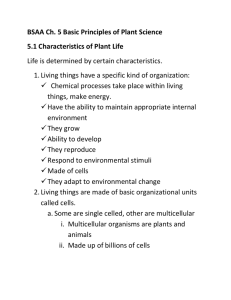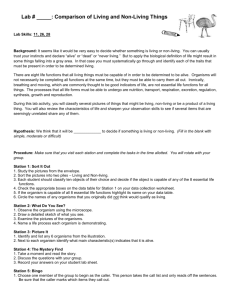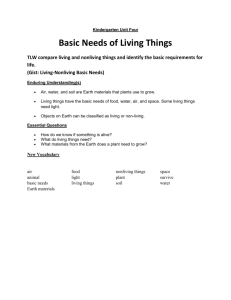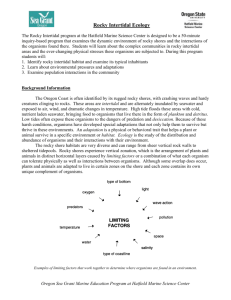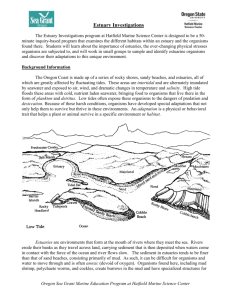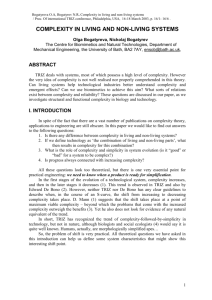Classification Booklet
advertisement
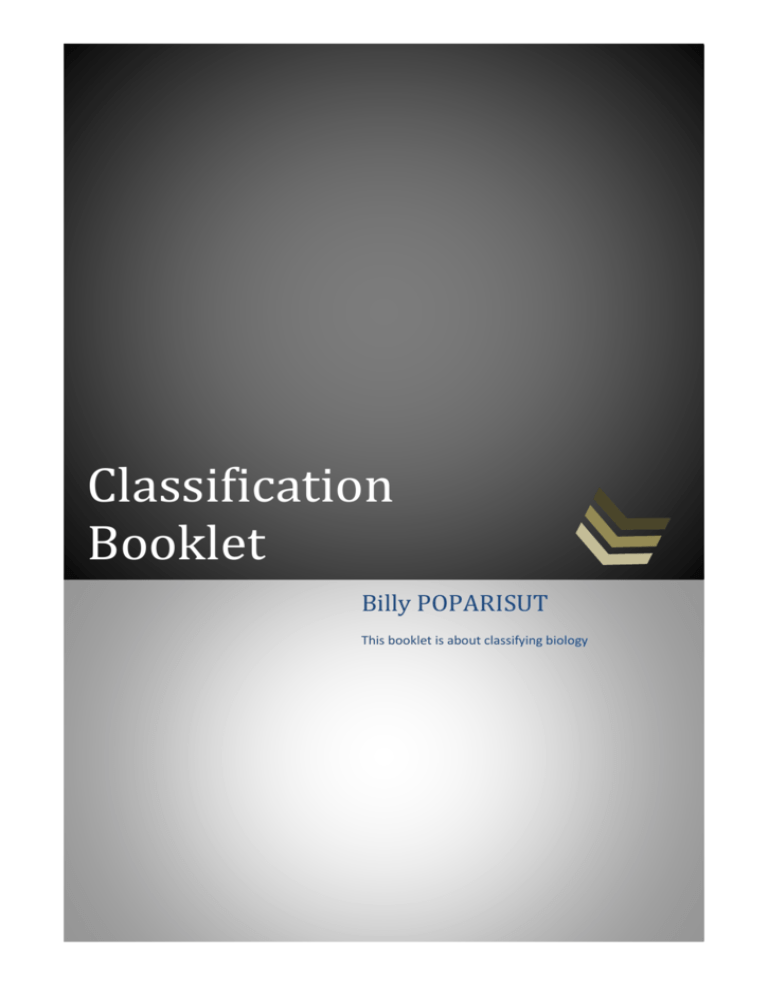
Classification Booklet Billy POPARISUT This booklet is about classifying biology Page 2 Page 3 Classification – Introduction HOMEWORK: KINGDOMS OF CLASSIFICATION Classification – Introduction Know how things can be classified Understand the reasons why we classify things Classifying lab equipment Place the items in the appropriate category (items can be used twice): Lab coat, beaker, thermometer, scale, gauze mat, conical flask, Bunsen burner, gloves, test tube rack, retort stand, test tube, tongs, measuring cylinder, stopwatch, tripod, safety glasses, newton meter Protective Lab Coat Gloves Safety glasses Glassware Beaker Conical flask Measuring cylinder Measuring Thermometer Scale Newton meter Measuring cylinder Heating Gauze Mat Bunsen Burner Holding Test tube Test tube rack Tripod Retort stand tongs 1. How are things classified? By their unique features 2. Why do we classify living things? Because there are many differences in things Plant or Animal Connect Four 1. What characteristics do plants and animals have in common? They are both living 2. What characteristics are unique to plants? They produce oxygen 3. What characteristics are unique to animals? They have blood 4. Can you name any living organisms that are neither plants nor animals? There are the molluscs and bacteria Classifying students Classify 5 of your classmates according to their physical characteristics. Brandon Jacob Billy Aaron Eye color Hair color Gender Height Skin color Blue Blue Brown Brown black blonde black brown male male male male Shorter Taller Medium Medium pale pale tanned Pale 5. Complete ‘Classification’ booklet title page including student name and images. HOMEWORK: KINGDOMS OF CLASSIFICATION Read Science Quest page 60-62 1. Name the person who is recognized as having developed the naming system for all living things. The Swedish naturalist Carolus Linnaeus (1707–1778) 2. How are living organisms grouped? If things have similar or unique features they are grouped together 3. Use a flow chart to show the names of the 7 groupings in the hierarchical classification system, from largest to smallest. 4. Identify which group contains members that have the most in common in each of the following pairs. a. Kingdom or species the kangaroos b. Genus or family kangaroo and wallaby c. Order or phylum kangaroo and wallaby d. Class or order the kangaroos 5. List the five kingdoms of living things. Research 6. Describe some features of each of the five Kingdoms and provide an example of an organism that belongs to each kingdom. Animalia Living breathing and big Snow leopard animals Prokaryotae, 1cell no nucleus Bacteria King Phillip Came Over For Good Spaghetti Protoctista 1 cell have a nucleus Algae Fungi Can’t move, some are edible Mushroom Plantae Same as fungi but all edible Sunflower 1. Choose an animal and state the name of the 7 ranks listed in question 3 to which the animal belongs. (an example is provided) Common Name: Kingdom: Phylum: Class: Order: Family: Genus: Species: Cheetah Animalia Chordata Mammalia Carnivora Felidae Acinonyx Jubatus Olive-ridley turtle Animalia Vertebrata Reptilia Testudines Cheloniidae Genus Lepidochelys Olivacea Living or non-living? Identify if something is living or non-living Know the characteristics of life All living things can… Place the following characteristics of living things in the appropriate place: sensitivity, movement, growth, nutrition, respiration, excretion, reproduction Characteristic Description Movement All organisms can move. Animals can swim, fly, walk, or run. Plants grow towards or away from light, water, or gravity Reproduce All organisms can make more of their own kind. Humans can have babies, plants produce seeds. Sensitivity All organisms can detect their environment. We can see, hear, smell, taste, and touch. Plants can detect light, water, or gravity. Grow All organisms can get bigger. “From little acorns great Oak tress grow” Respiration All organisms need oxygen to release energy from food by respiration. Excretion All organisms produce waste. Humans produce carbon dioxide and urine. Plants produce oxygen Nutrition All organisms need food. Animals need to eat food. Plants can make their own by photosynthesis. What is the name that will help you remember the characteristics of life? And what characteristic does each letter represent? Movement Reproduction Sensitivity Growth Respiration Excretion Nutrition What is the mnemonic that will help you remember the order of classification of living things and what does each letter stand for? King Phillip Came Over For Good Spaghetti Is it alive? Science Quest 7 pages 103-105 Living, non-living or dead ● Complete the table below. Robo-Billy Characteristics (electronic toy) Billy Billy fossil Is able to move Yes Yes No Requires oxygen No Yes No Requires water No Yes No Requires nutrition No Yes No Responds to changes in its No yes No environment Produces waste and excretes No Yes No Grows as it gets older No Yes No Reproduces itself No yes No it 1. Which of the three bilbies is non-living? Which characteristics does it have? Toy is non-living 3. Which of the three bilbies is dead? Which characteristics does it have? Fossil Billy 4. Which characteristics does the living bilby have? Everything it needs to be living Complete the table below. ● Characteristics Paper Fire Tree Is able to move No Yes No Requires oxygen No Yes Yes Requires water No No Yes Requires nutrition No Yes Yes Responds to changes in its No No Yes No Yes Yes Grows as it gets older No Yes Yes Reproduces itself No Yes Yes environment Produces waste and excretes it 5. Which of the following are non-living: paper, fire or tree? Paper is non-living 6. Does the living thing have all of the characteristics listed? No 6. Which characteristics does the living thing have that the non-living thing does not? A living thing breaths, needs water and nutrition

